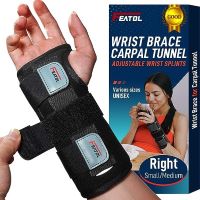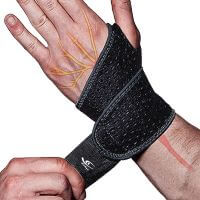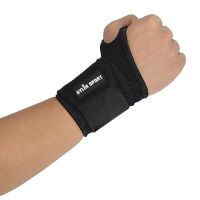Pickleball, a popular sport that combines elements of tennis, badminton, and table tennis, has gained a significant following in recent years. However, like any physical activity, pickleball can sometimes lead to injuries and discomfort, particularly in the wrists. Wrist pain is a common issue among pickleball players, and addressing it is crucial for maintaining a healthy and enjoyable playing experience.
In this guide, we will explore the causes of wrist pain in pickleball, discuss preventive measures to minimize the risk and provide effective strategies for managing and alleviating wrist pain. Whether you’re a seasoned player or just starting out, this guide will equip you with the knowledge and tools to protect your wrists and continue playing pickleball with confidence and comfort.
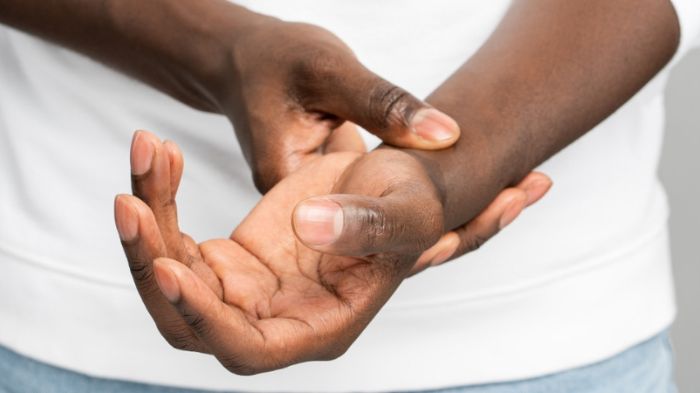
You Might Also Like:
Common Causes of Wrist Pain in Pickleball
- Repetitive Stress and Overuse Injuries: The repetitive nature of pickleball strokes, such as volleys, smashes, and dinks, can exert strain on the wrist joint. The constant repetition of these movements can lead to inflammation, tendonitis, and discomfort in the wrist. Engaging in intense or prolonged play without giving your wrist sufficient rest and recovery time can further increase the risk of overuse injuries.
- Inappropriate Paddle Grip or Technique: Your wrist health can be significantly impacted by the way you grip the pickleball paddle and execute your shots. Overly tight gripping the paddle can place undue strain on the wrist joint, causing pain and discomfort. Similar to improper technique, excessive wrist flicking increases the risk of wrist strain. Additionally, playing with a paddle that is overly heavy or not balanced properly might put unneeded strain on the wrist.
- Improper Warm-up and Stretching: Your muscles and joints, including the wrist, may not be ready for the rigors of pickleball if you don’t warm up and stretch properly before playing. Your wrist and forearm muscles may be more prone to strain and injury without enough warm-up activities. Similarly to this, failing to stretch the muscles in the wrist and forearm can lead to stiffness and restricted flexibility, increasing the chance of wrist pain and discomfort while playing.
- Pre-existing Conditions or Injuries: Individuals with pre-existing wrist conditions, such as arthritis or tendonitis, may experience heightened symptoms while playing pickleball. The repetitive motions and impact on the wrist joint can exacerbate existing conditions, leading to increased pain and discomfort. Additionally, previous injuries or trauma to the wrist, such as sprains or fractures, can make the wrist more vulnerable to pain and discomfort during pickleball play.
Signs and Symptoms of Wrist Pain
- Pain or Discomfort during or after Playing Pickleball
One of the most common signs of wrist pain is experiencing pain or discomfort specifically during or after playing pickleball. The pain may be more pronounced during wrist movements, such as when executing shots or performing volleys.
It can also be felt while gripping the pickleball paddle firmly. This pain may range from mild discomfort to sharp, shooting pain depending on the severity of the issue.
- Swelling, Tenderness, or Inflammation in the Wrist Area
Wrist pain in pickleball can be accompanied by visible signs of inflammation. Swelling around the wrist joint is a common symptom, indicating that there may be an underlying issue causing the discomfort.
The wrist area may also feel tender to the touch, and the skin around it might appear red or inflamed. These signs suggest that there may be inflammation or irritation in the tissues surrounding the wrist joint.
- Limited Range of Motion or Difficulty Gripping the Paddle Firmly
Wrist pain can lead to a decreased range of motion in the affected wrist. You may experience stiffness or a reduced ability to move your wrist freely, making certain pickleball shots or actions challenging.
Additionally, you might find it difficult to grip the pickleball paddle firmly due to pain or weakness in the wrist. This can affect your control, accuracy, and overall performance on the court.
Prevention and Management Strategies
No pickleball player wants to stay injured. When you find out that you have wrist pain after playing pickleball, the next time you should try to take some precautions in order to continue your pickleball career ahead.
Proper Paddle Grip and Technique
Maintaining a relaxed grip on the pickleball paddle is essential to minimize stress on the wrist. Excessive tension in the wrist can lead to discomfort and potential injuries.
Seeking guidance from a qualified instructor can help you learn the correct paddle grip and technique, ensuring that you are using the proper form and reducing strain on the wrist.
Adequate Warm-up and Stretching Exercises
Prior to playing pickleball, it is crucial to engage in a thorough warm-up routine. This routine should include specific stretches for the wrist and forearm muscles to prepare them for the demands of gameplay.
By incorporating dynamic wrist movements, such as wrist circles, you can improve the flexibility and range of motion in your wrist, reducing the risk of injuries.
Strengthening and Conditioning Exercises
Performing targeted exercises to strengthen the wrist and forearm muscles is beneficial for improving stability and reducing the likelihood of wrist pain.
These exercises can involve wrist curls, forearm pronation, and supination exercises, or using resistance bands. Consulting a physical therapist or fitness professional can help you develop a personalized exercise program that suits your needs and goals.
Rest and Recovery
Allowing sufficient time for rest and recovery between pickleball sessions is vital for preventing overuse injuries. It is important to listen to your body and take breaks if you experience any discomfort or pain in the wrist. Giving your wrist adequate time to rest and recover will promote healing and reduce the risk of further injury.
Use of Wrist Supports or Braces
Consider using wrist supports or braces during pickleball play to provide additional stability and support to the wrist joint. These supports can help reduce excessive movements that may strain the wrist and offer added protection against potential injuries.
However, it is advisable to consult with a healthcare professional or therapist to determine the most appropriate type of support for your specific needs.
When to Seek Medical Attention?
Knowing when to seek medical attention for wrist pain is crucial to ensure proper diagnosis and timely treatment. If you experience persistent or worsening wrist pain despite rest and self-care measures, it is advisable to consult a healthcare professional.
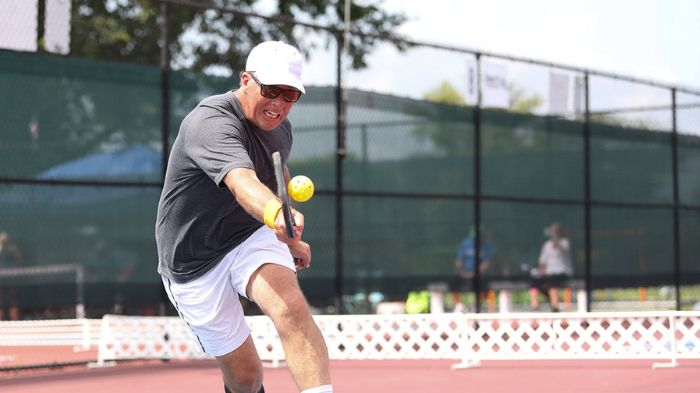
The inability to perform daily activities due to wrist discomfort, such as writing, gripping objects, or performing household chores, is also a sign that medical attention is needed. Immediate medical attention is necessary if you suspect a more severe injury, such as a fracture, dislocation, or ligament tear, especially if you experience severe pain, visible deformity, or inability to move the wrist.
If you have a pre-existing wrist condition or a history of wrist injuries, consulting a healthcare professional is recommended if you experience a flare-up of symptoms or unmanageable pain. Additionally, if your wrist pain does not improve within a reasonable timeframe despite self-care measures, it is advisable to seek medical attention for further evaluation and targeted treatment options.
Tips for Preventing Future Wrist Pain
- To prevent wrist injuries in pickleball, it is important to implement proper warm-up and cool-down routines before and after each session, ensuring that your muscles and joints are properly prepared and recovered.
- It is crucial to avoid overexertion and gradually increase the intensity and duration of your gameplay to prevent excessive strain on your wrists.
- Using equipment that is appropriate for your skill level and ensuring it is in good condition can significantly reduce the risk of wrist injuries during pickleball matches.
- Seeking guidance from a coach or instructor is highly beneficial as they can provide valuable advice on improving your technique, helping you minimize the risk of wrist injuries, and enhancing your overall performance in the game.
FAQs
The common causes of wrist pain in pickleball include repetitive stress and overuse injuries, incorrect paddle grip or technique, improper warm-up and stretching, and pre-existing conditions or injuries.
To prevent wrist pain in pickleball, it is important to use proper paddle grip and technique, engage in adequate warm-up and stretching exercises, strengthen and condition the wrist and forearm muscles, take regular rest and recovery periods, and consider using wrist supports or braces during play.
Yes, there are specific exercises and stretches that can help alleviate and prevent wrist pain in pickleball. These may include wrist stretches, forearm exercises, and strengthening exercises targeting the wrist and forearm muscles. It is recommended to consult a physical therapist or fitness professional for personalized recommendations.
You should seek medical attention for your pickleball-related wrist pain if it is persistent or worsening, if it significantly affects your ability to perform daily activities, if you suspect a more serious injury such as a fracture or ligament tear, or if you have a pre-existing wrist condition that flares up or becomes unmanageable.
Strategies for managing and recovering from pickleball-related wrist pain include resting and avoiding activities that aggravate the pain, applying ice or heat therapy, using over-the-counter pain medications, wearing wrist supports or braces, modifying playing technique or grip, and gradually returning to pickleball after sufficient rest and rehabilitation. In more severe cases, medical interventions such as physical therapy or corticosteroid injections may be recommended.
Conclusion
addressing and managing wrist pain is crucial for pickleball players to continue enjoying the sport. By understanding the common causes, recognizing the signs and symptoms, and implementing effective prevention and management strategies, you can protect your wrists and maintain a pain-free playing experience in the exciting world of pickleball. Stay active, stay safe, and keep having fun on the pickleball court!

